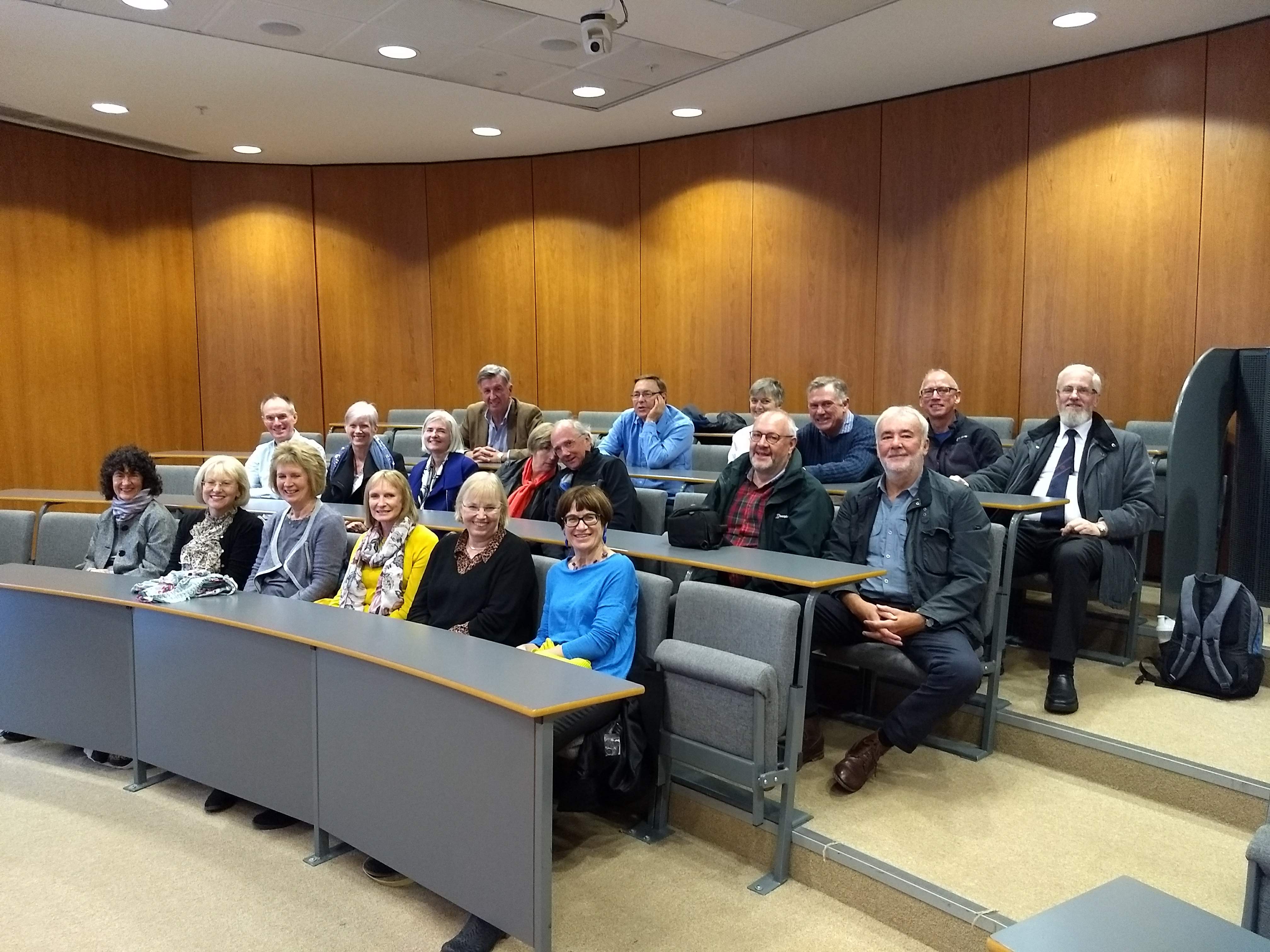
On Friday and Saturday this week I met with ‘old’ medical colleagues whom I had not met for 40 years. It was the 40th anniversary of the 1978 Gamma Year Club, the Medical class who graduated with me from Glasgow University in 1978.
Time had worked on most physiognomies and some were unrecognisable, which was not surprising as they proved to be spouses of colleagues! What did surprise me was that it was easier to recognise some of my colleagues by their voice. It seems our voice changes less over time than our appearance.
There were various events scheduled for Friday and Saturday and I managed most of them and a few of my own. The main event was the meal on Saturday evening, which I had planned to attend until the death of my brother Andrew changed my long-term planning and I had to return home late on Saturday afternoon. Another close colleague, Moray Fraser, could not attend because his 93-year-old mother had passed away to her eternal rest the same week. I hope to meet up with him at her funeral on Monday.
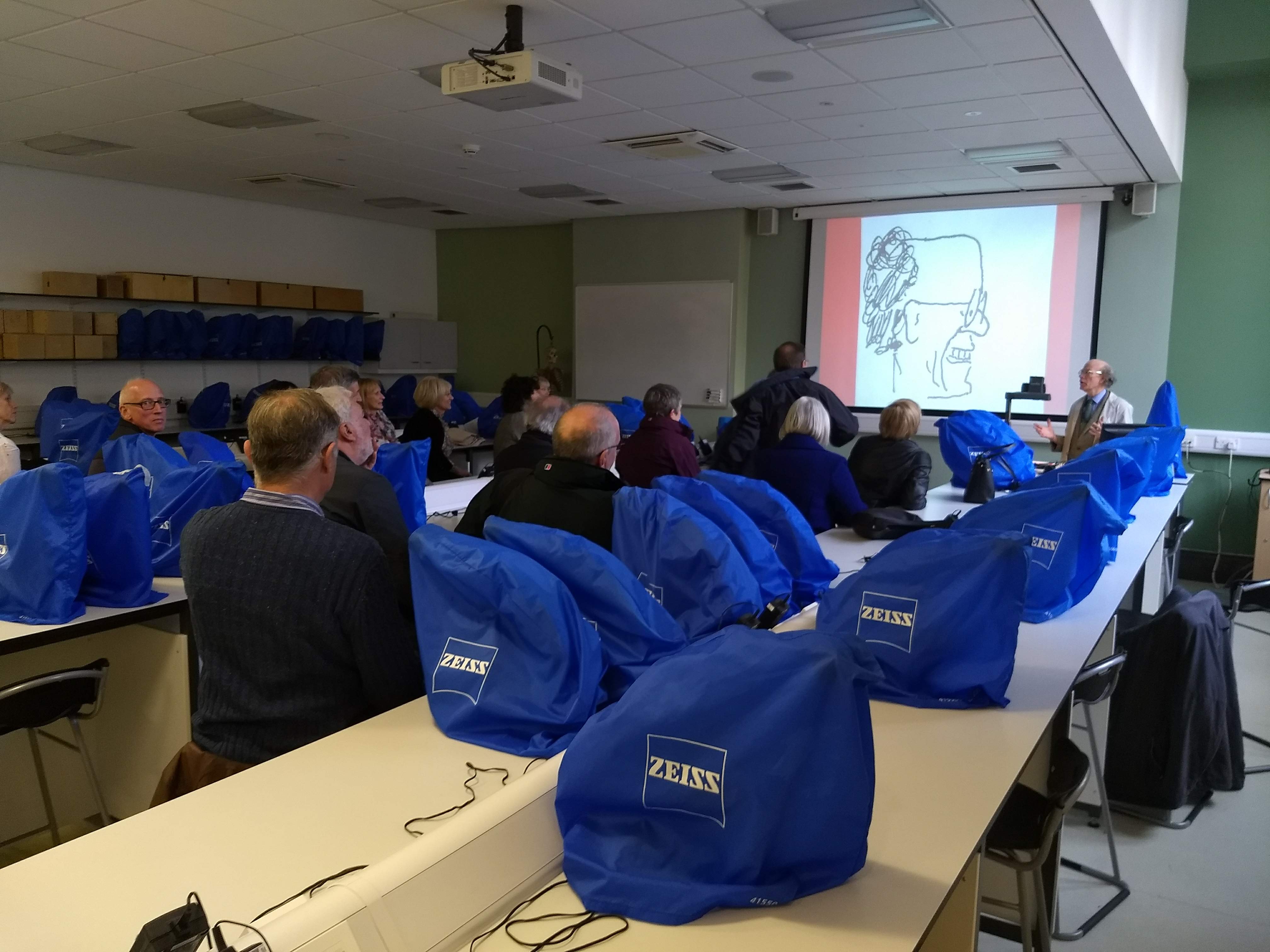
The highlight was meeting our former anatomy lecturer, Dr John Shaw-Dunn, who ‘came out of retirement’ to take us down memory lane and to give us a tour of the Clinical Anatomy Skills Centre (CASC). The smell of formalin told us we were on familiar and authentic turf. Shaw-Dunn was a splendid teacher and used to draw beautiful diagrams on the blackboard. Now updated with a whiteboard, he obliged my request to video him ‘in action’, with a brief sketch of the brachial plexus. However, the photograph shows that he prefers and has ‘upgraded’ to an overhead projector.
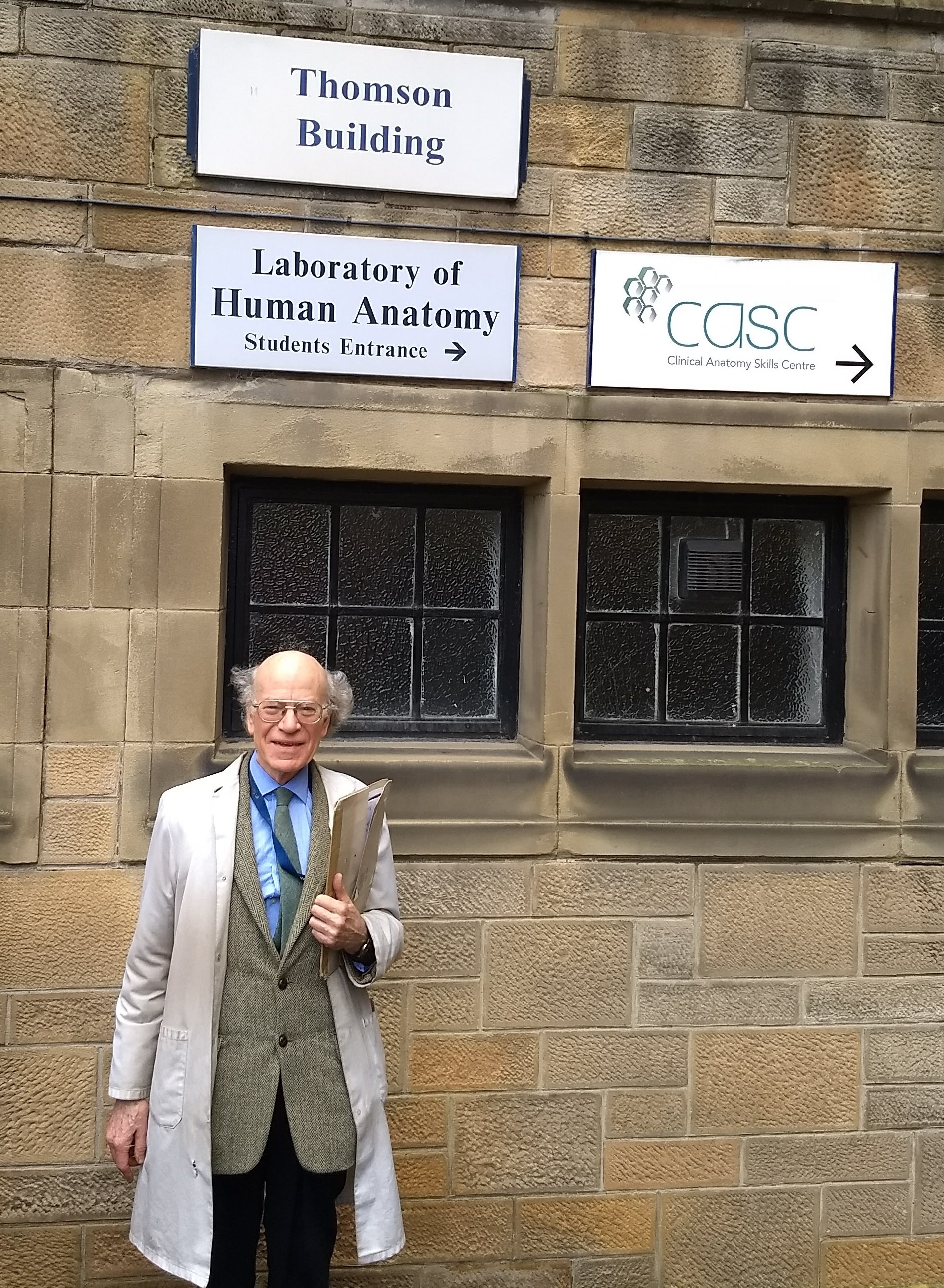
I have often quoted a saying from one of his early lectures in 1972: “Here at Glasgow, we don’t read textbooks – we write them.” Bursts of that eloquence had not deserted him and were on copious display to delight his admirers at yesterday’s impromptu address.
I loved anatomy as it showed me the glory of our Creator in the intricacies of the human body. It was fascinating to learn for the first time how muscles worked at the molecular level. I still have my drawings and lecture notes and I expected to get a Distinction in the subject but medical politics intervened. When I returned to medicine in 2000, after 20 years in the Christian ministry, possibly I should have considered radiology because the anatomy of the human body had not changed in the interim, unlike medical treatment and technology, which required a tremendous effort to assimilate in a short period of time. There is now a shortage of radiologists, delaying many medical procedures.
This increase in medical knowledge reminds me of another anecdote from our student days, which I have often repeated. At our 30th-anniversary reunion at Fairmont Hotel in St Andrews in 2008, there were three 30 Years Progress presentation – in Bone Disease from Stuart Ralston at Edinburgh, in Inflammatory Arthritis from Tom Pullar at Dundee and in Gastroenterology from Colin Howden, translocated to America, each ‘at the top of their game’. Ex-pat Colin reminded us that Charlie Forbes in Glasgow Royal Infirmary told us as students that 50% of what we were being taught would probably turn out to be untrue in 30 years’ time. The problem was – he didn’t know which 50% it was! I have repeated this often, and David Jamieson told me that he did the same in his teaching classes.
Instead of capitalising on my knowledge of anatomy, on my return to medicine I went into the heart of clinical and acute medicine and caught up on 20 years of medical advances. The Post-graduate Medical Dean had been out of anaesthetics for six years and told me it was impossible to do – I wrote to her when I pased my MRCGP exams with Merit. In the process I drafted a book on my experiences, Rip Van Winkel returns to Medicine.
On this 40th anniversary, my trip down memory lane began at the top of University Avenue where the decorative gates record the names of early Principals, including Robert Boyd of Trochrig in Ayrshire from where my Boyd forebears hail, who had the noted distinction of being principal of both Glasgow and Edinburgh Universities.
The medical reunion events on this occasion began with a tour around the new Wolfson Medical School Building, built since our student days and opened by the Princess Royal on the 3rd of April 2003. There were many donors to finance the project and I noted two more Boyds, my father and my aunt, in the ‘gold brick’ section, as it was my first visit to the building. We were shown the clinical skills lab and noted students sitting around or in tutorials. Then we had a short presentation about the developments at Glasgow University, both in terms of the student curriculum and the £1.1 billion building refurbishments.
Surprisingly, as the top picture shows, the lecture theatre is quite small and cannot accommodate the three hundred or so students expected in this year’s intake of medical students. This is because the Wolfson was built in an era when problem-based learning (PBL) was the flavour of the month. This meant that students were taught in small groups rather than attending lectures, so a large lecture theatre was surplus to requirements – or so it was thought at the time. The PBL hegemony has been dismantled since then, but it has left its legacy. The building has a huge atrium, where students sit on the floor without any seating, as well as a lecture theatre with inadequate seating. There is a lesson here and not simply the obvious one that one should not allow a new ideology to overwhelm conventional wisdom, especially at a time when capital projects are being determined, but it is also an example how intelligent people can meekly comply with authority figures. This is a more serious issue and it is a sign of our times when political correctness is the flavour of the month. Christianity delivers us from such servile submission by teaching counter-cultural thinking and standards.
After Shaw-Dunn’s presentation at the end of the afternoon, I visited the Reading Room for old times’ sake, where I had spent many an hour studying in the 1970s. This time I had my laptop computer, and how I wish we had such devices in the 1970s. I was the first to use a PDA (personal digital assistant) in Raigmore Hospital in 2000 to record my copious note-taking. Now everything is electronic.
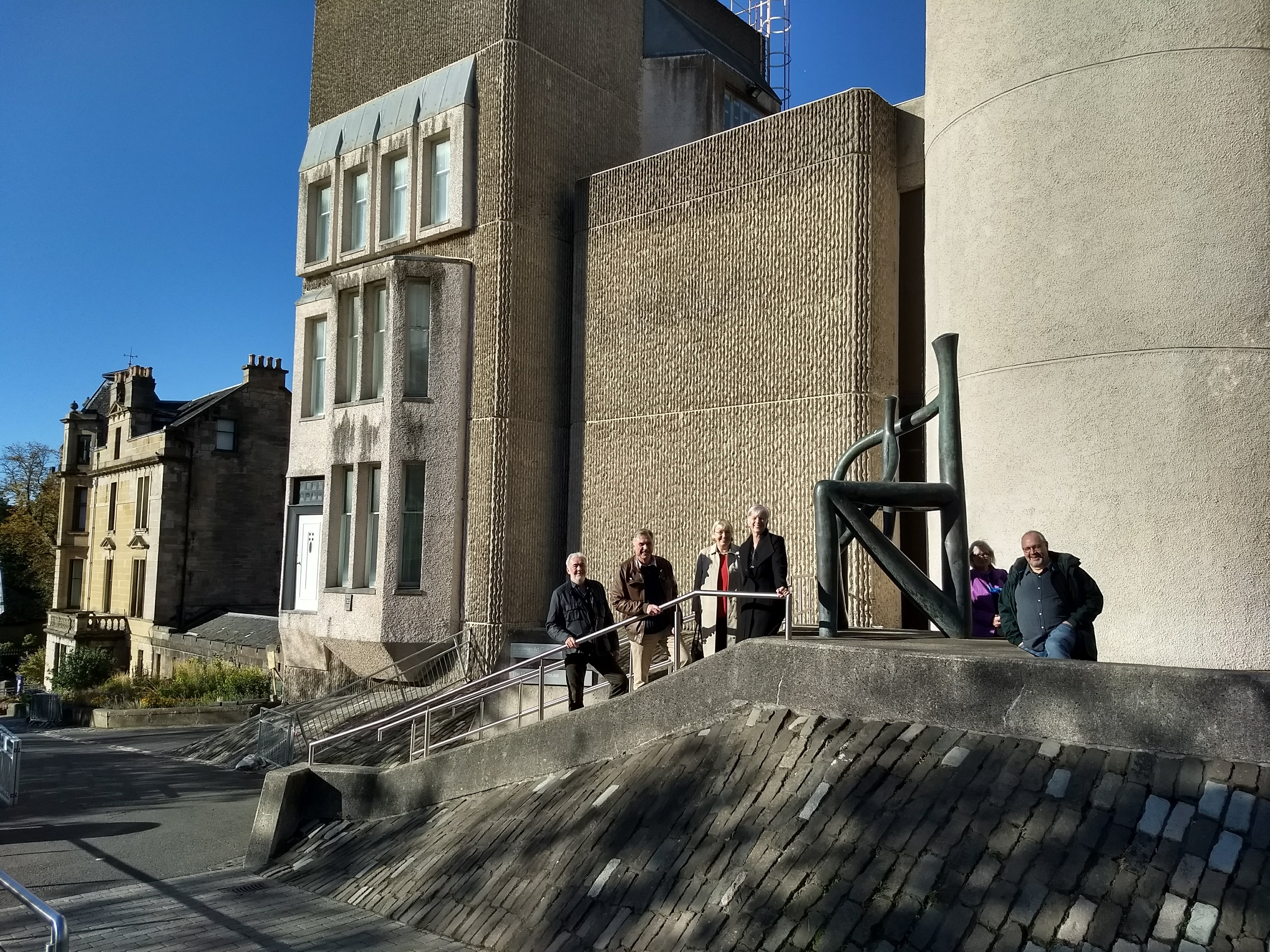
The next day, Saturday, began with a tour round Charles Rennie Mackintosh’s reconstructed house in the Hunterian Art Gallery beside the library. The original had been demolished to make way for the current University Refectory where I had consumed many a meal in my student days and where and when I first read Jonathan Edwards’ famous sermon on Sinners in the Hands of an Angry God. The Mackintosh building reminded me of my 30th wedding anniversary meal in House for an Art Lover, Bellahouston Park, Glasgow, one of CRM’s designs that had never been built in his lifetime. Five years ago it had display boards of the 1938 Empire Exhibition held in Bellahouston Park, which my father attended as a young boy, who pointed out to me various features he had visited at that time. It also reminded me that one of my friends is the first life member of the Charles Rennie Mackintosh Society, a retired architect living in Lewis in a house full of CRM memorabilia. Another of CRM’s house designs has been built near my former home in Farr, by Inverness.
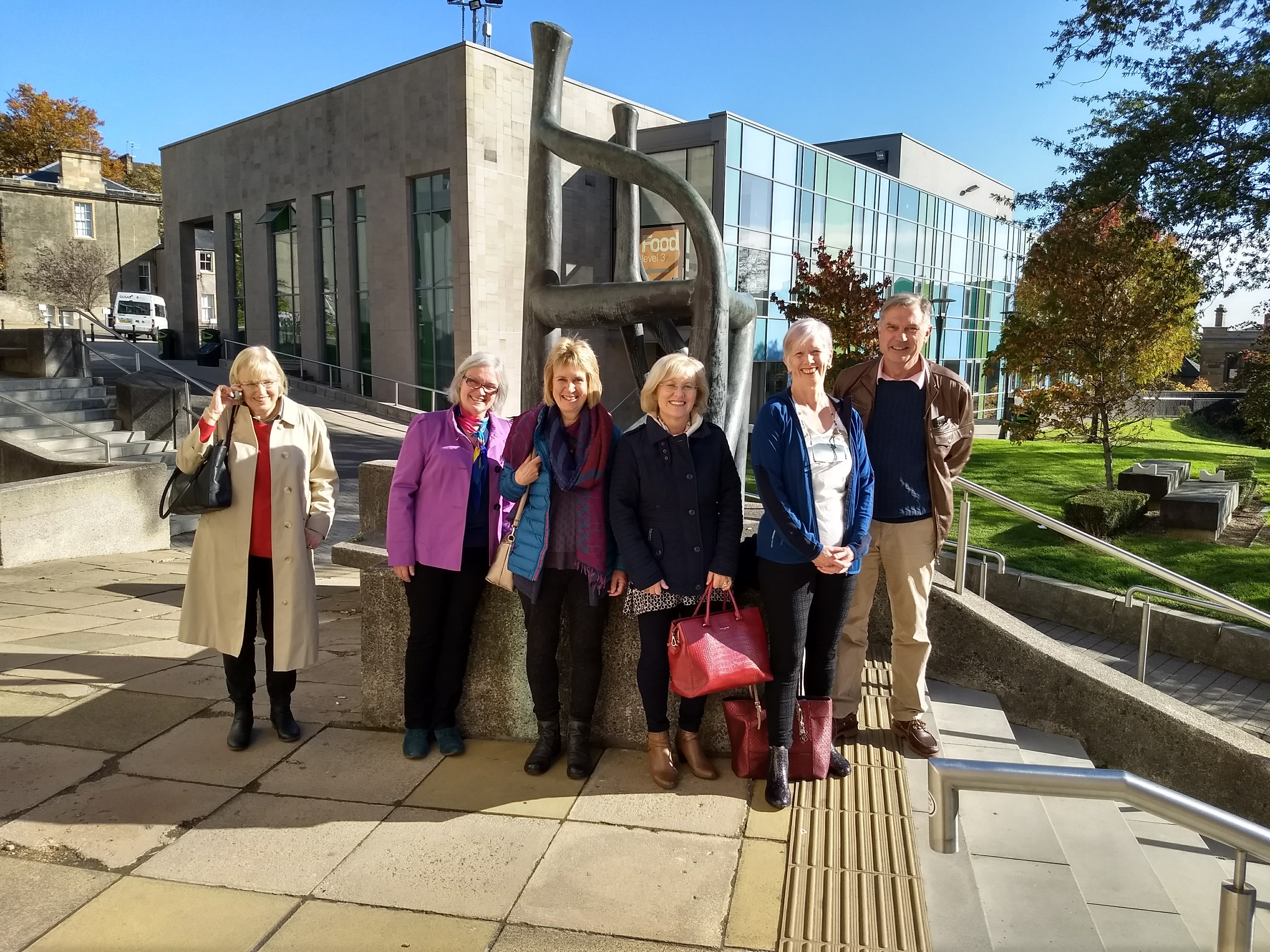
This tour was followed by a visit to the famous Hunterian Museum where I saw Hunter’s copy of Adam Smith’s Wealth of Nations signed “from the Author”. The museum houses more than the anatomical specimens for which it is renowned. There was a record of Scottish coinage since King David I and here I learned that Inverness has minted coins more than once, during the reigns of Alexander II and James I. We passed the robing room reminding me of the occasion when my father Dr James Boyd and sister Dr Joan McDowell paraded as members of the Senate at the graduation of my son James in the Bute Hall. There were many memories.
Standing in the Hunterian Museum, appropriately in the bowels of Glasgow University’s main building atop Gilmorehill, bypassed by many, were the bones of the largest dinosaur to walk on Earth. The whole skeleton was not there but only the bones of one of its legs, reaching to the ceiling and wobbling precariously as I walked around it. Its knee was at the height of my neck and its thigh bone reached to the ceiling. This is Diplodocus, the creature described by Job in the oldest book of the Bible, the oldest extant book in human history still read on a daily basis, whose contents I am in the process of making more readily available. Job describes the activity and eating habits of this massive creature, to the consternation of evolutionists who do not understand mankind’s global history.
Only yards away, there is a display cabinet and a plaque reading: “The world’s most complete 330 million year old shark was found on the banks of a small stream in Bearsden, near Glasgow. The preservation of the shark is so good that blood vessels and muscles can be studied along with the shark’s last meal.” It is not explained how blood vessels can survive 330 million years. This evidently throws doubt upon evolutionary timescales. After all, Shaw-Dunn had just told us that his former anatomy dissection specimens lasted six months at best. Further, having food in its stomach demonstrates that it was overwhelmed by sedimentary deposits so quickly that the meal was not digested. This points to catastrophism in the geological record, only in recent decades being recovered from the dustbin into which evolutionary uniformitarianism tried to consign it. “But facts are chiels that winna ding” as the Scottish bard put it.


More colleagues joined us, including Kathy Walsh who told me she worked in pathology and often met my father at pathology conferences. While touring the Hunterian museum Alan Walker kindly showed interest in my portfolio career so I briefly described my four or more reincarnations. After my mathematical and scientific interests at school, my first career was as a medical doctor, then as a minister of the Gospel of the Lord Jesus Christ, then a return to medicine in 2000, then combining these disciplines into Christian politics in 2006 and finally beginning to output my lifelong writing in my next publishing phase. However, these metamorphoses are a mere external description and do not explain the essence of the man. The metamorphosis of a caterpillar into a butterfly ought to pause intelligent medics in their tracks and to remind them of the glory of their Creator Who has designed such an intricate genetic blueprint to accomplish such remarkable changes. Well do I remember showing my copy of Bones of Contention, by Sylvia Baker, to fellow medical students in the anatomy lecture room in 1972, and my fellow medical student Moray Fraser’s father gave me his copy of the ground-breaking book The Genesis Flood by Henry M. Morris, an American professor of civil engineering whose textbook on engineering hydraulics was a standard text in many universities, who opened my youthful eyes to the power of water to shape geology. The extraordinary changes in the natural world illustrate the metamorphosis in the spirit of man when the divine Holy Spirit of Jesus Christ regenerates the soul of man and makes him ‘a new creature’ 2Cor 5:17. This is the essence of the godly person. The apostle Paul explains it: “By the grace of God, I am what I am” 1Cor 15:10. I used this epithet to sum up myself on Axiom, a BBC television programme in 1994 about Christianity in Scotland called “Are we now beyond belief?” Stuart Cosgrove, standing in for Kirsty Wark, gave me the last word in the debate in which I said that the post-Christian era was wishful thinking and I quoted Mat 28:18-20.
The metamorphosis of a caterpillar into a butterfly should direct thinking people towards the rapid change in lifeforms through natural selection, rather than the current unsustainable paradigm of millions of years dreamed up in the evolutionary hypothesis. It should also remind us of ‘the butterfly effect’ and chaos theory, another manifestation of the extraordinary intricasy of human existence on the surface of this extraordinary planet in our extraordinary solar system.
When our discussion turned to the distinctives of Christian politics, we were joined by Donald McGeachy who had a common interest in politics. Just as there is good and bad religion, so there is good and bad politics, good and bad lawyers and good and bad doctors. Intelligent people should lead the way in establishing the truth, but often the pride of intelligent people can beguile them into thinking that they have little to learn from others whom they judge as unable to teach them.
It was now late afternoon and I reluctantly took my leave of my former colleagues and went to visit the University Library, changed internally out of all recognition. It had acquired an annex since the 1980s, expanding the width of every floor and adding to my disorientation. I updated my Life Membership card and discovered that I belonged to a rare and dying breed because life membership is no longer available to graduates. I joined a half-hour tour to learn the layout and usage of the ‘new’ library, celebrating its 50th anniversary this year. One lassie on this tour was beginning a Ph.D. in personalised medicine, a subject I had discussed with Shaw-Dunn only the previous day. I noted that the medical floor was now shared with other disciplines and that the section of medical books is reduced to a mere four rows because most resources are now online. I questioned locating the rare book section on the 12th floor at the top of the building. It used to be in the basement, and I suppose the risk of flooding while putting out a fire in higher floors changed this location, but the towering infernos of recent times do not augur well for the top floor either. Anyway, I settled down on the 10th floor, the theology floor, and worked on the exegesis of my Bible commentary until it was time to catch the bus back north.
In my memory-lane discussions about absent colleagues with hard-to-recognise present colleagues, I discovered the extraordinary fact that random names of long forgotten colleagues would come up into my memory, as if my memory was running through the vaults below Glasgow Royal Infirmary, dark, dusty and labyrinthine, to emerge with a long-forgotten name. Memory is a wonderful and extraordinary thing that I have studied since my medical student days. “Remember now thy Creator, in the days of thy youth, before the evil days and years come when thou shalt say, I have no pleasure in them” Ecclesiastes 12:1.
It may be, as memory continues to wander through these sub-cortical corridors, that there may be more to add to this blogpost in due course. To my former colleagues who stumble over this contribution to their memories, I would like to catch up on the rest of your story in heaven, because there is not enough time to do so here on Earth – but you need to find your way there first. The Way to heaven is a Person, not the church, and Jesus Christ will not fail you if you trust in Him. He is more than the sum total of all that is best in all the human beings you have ever met. The Christian church is meant to help you on your journey to heaven by introducing you to Jesus Christ.
The Lord Jesus Christ said: ‘I am the Way to the Father’s house.’
John 14:6
Update:
10 Oct 2018: will you believe that BBC Newsnight finished tonight with a report that on average we can recognise 5000 faces? How does this compare with recognising voices, and with faces that change over the decades?
11 Oct 2018: thanks to all those emailing me about Andrew’s passing. I like to multitask and while picking up my emails I am watching the live repeat of Antiques Road Trip Series 12 Episode 4. It has just shown at 22’20 auctioneer Catherine Southon at another Charles Rennie Mackintosh house, Hill House in Helensburgh, designed in 1905 as the family home for the Blackie publishing family. After creating the Glasgow School of Art this was a rare domestic commission and the commentator said that despite international acclaim commissions were hard to come by at home in the UK. Lorna Hepburn said that there were many avenues Mackintosh could have gone down, but the architectural avenue closed down partly because of the first World War and partly because of “his feeling that he was not appreciated, he was not understood by the Establishment.” Unsung heroes are not uncommon. This clipping closed with a brief shot of the Scotland Street School Museum and the House for an Art Lover. Mackintosh Queen’s Cross is the CRM Society’s International headquarters and it is the only church designed by Mackintosh to be built.
22 Feb 2019: I took my young grandson Marcus Donald to see Dippy the Diplodocus on tour in the Glasgow’s Kelvingrove Art Gallery and Museum from 22 January – 6 May 2019. The full-sized skeleton was impressive to behold, but without its flesh and skin, its significance seems to have been lost on Marcus Donald who was more impressed with the more recognisable but much smaller elephant nearby.
3 May 2019: a few months later the skeleton of Dippy’s smaller and more ferocious cousin Tyrannosaurus rex was on display across the road in the Kelvin Hall, where Billy Graham had his famous Crusade in 1955, who declared in May 1954 in preparation for that occasion: “I believe Glasgow is the most prayed-for city in the history of the Christian church.” Its relevance for me is that I was born in Glasgow’s Rottenrow Hospital in early 1955.
31 May 2019: Hill House is in the news for the novel method to preserve it from further weather damage inside a box of chainmail!
11 Jun 2019: Professor Brian Cox, in tonight’s BBC Series The Planets: Series 1.3. The Godfather – Jupiter, corrects current hypotheses about the development of our solar system. The recent discovery of exoplanets demonstrates that our solar system’s arrangement, with four small rocky planets closer to the Sun than the gas giants Jupiter, Saturn, Uranus and Neptune (DMB mnemonic: S-U-N), is not typical of other solar systems. In most solar systems, Earth’s region is empty and super Earth’s are closer to the Sun with thick toxic atmospheres; in other words, our solar system may be unique. To use Cox’s own words: “So places like this [Earth and its solar system] might be extremely rare.” The philosophical implications are well-known to Christians, but rather unsettling for secularists, who scramble to find explanations to support their unbelief.
31 Jul 2019: David Berlinski—Atheism and its Scientific Pretensions.
2 Mar 2022: personalised medicine is leading also to personalised nutrition.
You can read comments from others below.

My mother and I have just enjoyed reading your latest blog titled “memory lane 40 years on”. My mother knew some of the people you mentioned. The title of your blog brought back memories for me if I remember correctly in 1978 being in hospital getting my club foot sorted I think you were a doctor just starting out and you popped over to the ward in Yorkhill where I was a patient to visit me.
With regards to the “memory lane” part of your blog, it reminds me of a few years ago, I happened to be sitting at the front room window and a car drew up at a house near to us which had just been emptied as the owner had passed away. I went out to say hello to what I thought were new neighbours who were movong into our street, only to discover the new “neighbour” was someone I used to play with when we moved to where we now live and I hadn’t seen her for many years.
Had her mother NOT come down to see if she could give her a hand moving stuff into what was to be their new house, I doubt I would have realised that the female moving in was a former play-mate from years back. Memories Indeed
LikeLike
Donald
Enjoyed your reminiscence trip down memory lane very much – thanks for resurrecting some of my own memories of Glasgow University Library, 1971-76.
Despite my background in archaeology, history, languages and literature, I was assigned initially to Floor One, the ‘physical and earth sciences division’, with Physics (Natural Philosophy), chemistry, engineering, maths and computer science, with extensive collections of books and periodicals. I was later elevated to Floor Two, mainly geography and geology, and lots and lots of maps, one of my enduring delights. I once discussed these placements informally with the University Librarian, the formidable R. Ogilvie Mackenna, and he summarised the decision to place me initially on Floor One as ‘your first lesson in librarianship’. In other words, organising and finding the books people need, not comprehending their contents, is the essence of librarianship.
I moved to Inverness in 1980, and apart from a career break, 1985-92, served out my time there, retiring in 2009. Now, I don’t know when I ever found the time to work!
I got on well with most of the staff and students at GUL, but found many of the academic staff arrogant and difficult. I remember fondly when Ogilvie Mackenna ‘carpeted’ a professor who had shouted at one of the young issue desk girls, leaving her in tears – he was told in no uncertain terms to apologise to her in person or his library privileges would be suspended.
I must visit GUL soon to inspect the new layout. No comment on the rare books section except that the views from the top floor are unsurpassed (all the way to the Paps of Jura) so I am sure the staff are pleased about that, after the windowless basement.
best wishes
Norman
LikeLike
Thanks for the interesting feedback, Norman.
It is remarkable that our times overlapped (1972-78) but we only met when you came to Inverness. I remember your excitement when you met someone who not only knew about the book you were consulting in the old Inverness Kirk Session Library but who could act as a future resource.
For the benefit of others reading this blogpost, Norman is integral to local research in Inverness.
LikeLike
Donald – thank you for sending me a link to your blog post which I read this morning. As a non believer (to the extent that I don’t even care), I am struck by the apparent close parallels between (i) religion, and (ii) science, which seemed to emerge. My position being possibly summed up I suppose by the words of the Physics Nobel Laureate [for the unification of the strong and weak fundamental forces], Richard Feynman, “When Einstein published his theory of General Relativity people read it and understood it – at least five or six did. What can be said with complete certainty is that no one understands Quantum Mechanics”. These two theories are mankind’s greatest scientific achievements – one solely the work of one man, whilst the other had/has many parents (Christian religion i.e. Christ/God?).
So are we, or science and religion, in some strange way quantumly coupled or entangled? – (without in any way questioning your religious faith).
But it seems that Quantum Mechanics and Religion appear to end up in the same place – i.e. total uncertainty. [Not with-standing the fact that both these scientific theories have stood up to every test we have applied to them].
With best regards to Norman Newton for making our paths cross – or did he make the wavefunction collapse to produce a definite outcome?……. (i) does not give us the answer’s, and with (ii) we cannot pre-interpret the outcome even if its hidden in there.
LikeLike
Thank you for your comments, Sinclair. The quotation I like from Richard Feynman is: “It always bothers me that, according to the laws as we understand them today, it takes a computing machine an infinite number of logical operations to figure out what goes on in no matter how tiny a region of space, and no matter how tiny a region of time. How can all that be going on in that tiny space? Why should it take an infinite amount of logic to figure out what one tiny piece of space/time is going to do? So I have often made the hypothesis that ultimately physics will not require a mathematical statement, that in the end the machinery will be revealed, and the laws will turn out to be simple, like the chequer board with all its apparent complexities.” Richard Feynman ‘The Character of Physical Law’.
On “the apparent close parallels between (i) religion, and (ii) science” my latest blogpost is along the same line https://donaldboyd.org/2019/10/01/eternity-and-time/
“are we, or science and religion, in some strange way quantumly coupled or entangled?”. I mention this in https://donaldboyd.org/2015/11/04/the-spiritual-dimension/
On prediction, the Bible tells us that foretelling future events is a divine characteristic, which is why Christians believe in God.
LikeLike